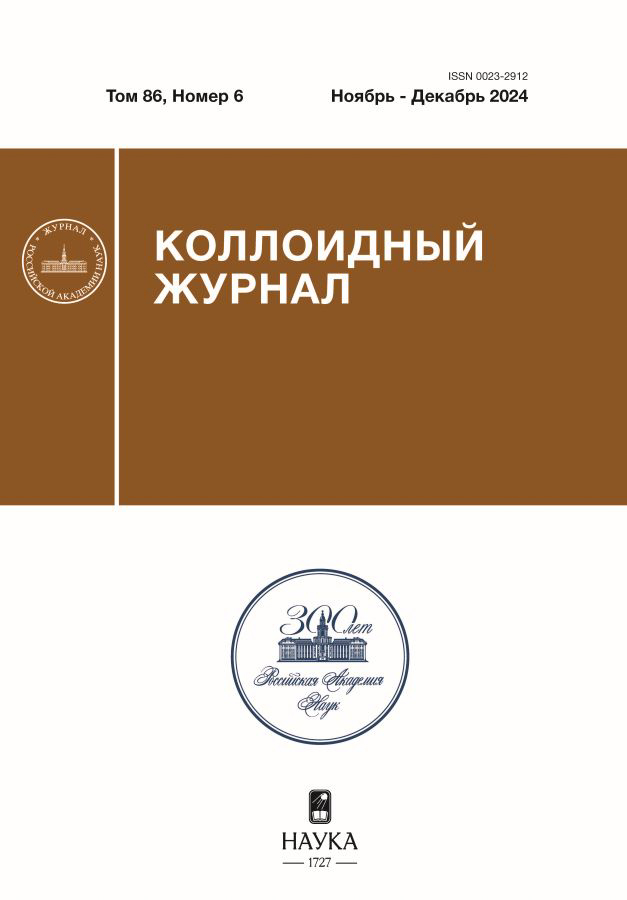Monitoring aggregation kinetics of colloidal systems by light scattering methods
- Authors: Alidzhanov E.K.1, Letuta S.N.1, Lantukh Y.D.1, Razdobreev D.A.1
-
Affiliations:
- Оренбургский государственный университет
- Issue: Vol 86, No 6 (2024)
- Pages: 679-686
- Section: Articles
- Submitted: 29.05.2025
- Published: 15.12.2024
- URL: https://cijournal.ru/0023-2912/article/view/681001
- DOI: https://doi.org/10.31857/S0023291224060018
- EDN: https://elibrary.ru/VLWXEK
- ID: 681001
Cite item
Abstract
The possibility of implementing an original methodology for studying the kinetics of aggregation of colloidal solutions based on the joint application of dynamic and static light scattering methods is discussed. The theoretical justification of the proposed methodology is based on the concept of fractal dimension and scaling. Its experimental implementation is carried out using the example of the aggregation process of a colloidal gold solution initiated by a change in the ionic strength of the solution. The fractal dimension of Au clusters is determined by the angular and kinetic dependences of static light scattering (SLS). The hydrodynamic radii of clusters are determined by the dynamic light scattering (DLS) method. Based on the experimental results and the formed model dependence of the light scattering intensity on the size of clusters, the kinetic dependence of the concentration of Au clusters is constructed and the rate of their aggregation is estimated. The proposed method can be applied to study the kinetics of aggregation of fractal clusters in various colloidal systems.
Full Text
About the authors
E. K. Alidzhanov
Оренбургский государственный университет
Author for correspondence.
Email: ekaalid@yandex.ru
Russian Federation, 460018 Оренбург
S. N. Letuta
Оренбургский государственный университет
Email: ekaalid@yandex.ru
Russian Federation, 460018 Оренбург
Yu. D. Lantukh
Оренбургский государственный университет
Email: ekaalid@yandex.ru
Russian Federation, 460018 Оренбург
D. A. Razdobreev
Оренбургский государственный университет
Email: ekaalid@yandex.ru
Russian Federation, 460018 Оренбург
References
- Russel W.B, Saville D.A.S., Schowalter W.R. Colloidal Dispersions: Cambridge Univ. Press, London, 1991.
- W. Hess, R. Klein. Generalized hydrodynamics of systems of Brownian particles // Adv. Phys. 1983. V. 32. P. 173–283. https://doi.org/10.1080/00018738300101551
- Lin M.Y., Lindsay H.M., Weitz D.A., Ball R.C., Klein R., Meakin P. Universal reaction-limited colloid aggregation. //Phys. Rev. A. 1990. V. 41. P. 2005–2020.https://doi.org/10.1103/PhysRevA.41.2005
- Huang Z., Zhang Q., Whatmore R.W. Studies of lead zirconate titanate sol aging Part II: Particle growth mechanisms and kinetics// J. Sol–Gel Sci. Technol. 2002. V.24. P. 49–55. https://doi.org/10.1023/A:1015161532663
- Ролдугин В.И. Свойства фракталных дисперсионных систем. // Успехи химии. 2003. Т. 72. № 11. С. 1027–1054. https://doi.org/10.1070/RC2003v072n11ABEH000829
- Carpineti M., Giglio M. Spinodal-type dynamics in fractal aggregation of colloidal clusters// Phys. Rev. Lett. 1992. V.68. P. 3327–3330. https://doi.org/10.1103/PhysRevLett.68.3327
- Carpineti M., Giglio M., Degiorgio V. Correlation and anticorrelation of fractal aggregates. A model for spinodal-type- aggregation // Nuovo Cimento D. 1994. V. 16 P. 1243–1246. https://doi.org/10.1007/BF02458807
- Axford S.D.T. Aggregation of colloidal silica: Reaction-limited kernel, stability ratio and distribution moments //J. Chem. Soc. Faraday Trans. 1997. V. 93. P. 303–311. https://doi.org/10.1039/A606195H
- John Gregory. Monitoring particle aggregation processes // Adv. Colloid Interface Sci. 2009. V. 147–148. P. 109–123. http://dx.doi.org/10.1016/j.cis.2008.09.003
- Holthoff H., Egelhaaf S. U., Borkovec M., Schurtenberger P., Sticher H. Coagulation rate measurements of colloidal particles by simultaneous static and dynamic light scattering // Langmuir, 1996. V. 12. № 23. P. 5541–5549. https://doi.org/10.1021/la960326e
- Gregor Trefalt, Istvan Szilagyi, Michal Borkovec. Probing colloidal particle aggregation by light scattering // Polymers, Colloids and Interfaces, Chimia, 2013. V. 67. P. 772–776. https://doi.org/10.2533/chimia.2013.772
- Sorensen C.M. Light scattering by fractal aggregates: A Review // Aerosol. Sci. Technol. 2001. V. 35:2. P. 648–687. https://doi.org/10.1080/02786820117868
- Sorensen C.M., Gregory C. R. The prefactor of fractal aggregates // Journal of Colloid and Interface Science 1997. V. 186. P. 447–452. https://doi.org/10.1006/jcis.1996.4664
- John Turkevich, Peter Cooper Stevenson, James Hillier. A study of the nucleation and growth processes in the synthesis of colloidal gold // Disc. Faraday. Soc. 1951. V. 11. P. 55–75.
- Krishnendu Saha, Sarit S. Agasti, Chaekyu Kim, Xiaoning Li, Vincent M. Rotello. Gold nanoparticles in chemical and biological sensing // Chem. Rev. 2012. V. 112, N.5. P. 2739–2779. https://doi.org/10.1021/cr2001178
- Olivier B.J., Sorensen C.M. Variable aggregation rates in colloidal gold: Kernel homogeneity dependence on aggregant concentration // Phys. Rev. A. 1990. V. 41. №. 4, P. 2093–2100. https://doi.org/10.1103/PhysRevA.41.2093
- Qicong Ying, James Marecek, Benjamin Chu. Slow aggregation of buckminsterfullerene (C60) in benzene solution // Chem. Phys. Lett. 1994. V. 219. P. 214–218.https://doi.org/10.1016/0009-2614(94)87047-0
- Э.К. Алиджанов, И.Е. Кареев, В.П. Бубнов, А.И. Котов, С.Н. Летута, Ю.Д. Лантух, Д.А. Раздобреев. Кинетика самосборки кластеров эндоэдральных металлофуллеренов в полярном растворителе // ФТТ. 2023. Т. 65, №. 9, С. 1618–1625. https://doi.org/10.21883/ftt.2023.09.56261.112
- Sakineh Alizadeh, Zahra Nazari. A Review on gold nanoparticles aggregation and its applications // J. Chem. Rev. 2020. V. 2. P. 228–242. https://doi.org/10.22034/jcr.2020.108561
- Xiong Liu, Mark Atwater, Jinhai Wang, Qun Huo. Extinction coefficient of gold nanoparticles with different sizes and different capping ligand // Colloids Surf. B. 2007. V. 58. P. 3–7. https://doi.org/10.1016/j.colsurfb.2006.08.005
- R. Hidalgo-Alvarez a, Martln A., Fernandez A., Bastos D., Martinez F., de las Nieves F.J. Electrokinetic properties, colloidal stability and aggregation kinetics of polymer colloids // Adv. Colloid Interface Sci. 1996. V. 67. P. 1–118. https://doi.org/10.1016/0001-8686%2896%2900297-7
- Taehoon Kim, Chang-Ha Lee, Sang-Woo Joo, Kangtaek Lee. Kinetics of gold nanoparticle aggregation: Experiments and modeling // J. Colloid Interface Sci. 2008. V. 318. P. 238–243. https://doi.org/10.1016/j.jcis.2007.10.029
Supplementary files

















